Fredrick II of Hohenstaufen and modern ecology
Niemelä Pekka; Vuorisalo Timo; Örmä Simo
https://urn.fi/URN:NBN:fi-fe2021120158523
Tiivistelmä
Emperor Frederick II’s early thirteenth-century book on falconry, De arte venandi cum avibus, is probably the most famous single source for scholars who survey the state-of-the-art in natural sciences in medieval times. Most of the research on his book has focused on the marginal illustrations featuring about 80 bird species. However, the book contains a large amount of ethological, ecological, morphological and faunistic knowledge about bird fauna. Frederick was also one of the first to conduct experiments with birds. Here, we describe the ornithological experiments and observations of Frederick and evaluate them from the perspective of modern ecology.
In many contexts, Frederick expressed criticism of Aristotle and his work Liber Animalium. Frederick’s observation upon the geographical variation of species was partially in contrast to the Aristotelian typological or essentialist species concept. This is an important finding from the point of view of the western history of biology.
De arte venandi cum avibus demonstrates Frederick’s deep knowledge of the ecology, morphology and behaviour of birds. This knowledge he gained via his long practice with falconry. The love of falconry made Frederick an early proponent of empiricism, and De arte venandi cum avibus was actually the most important achievement of empirical zoology in the thirteenth century.
Kokoelmat
- Rinnakkaistallenteet [27094]
